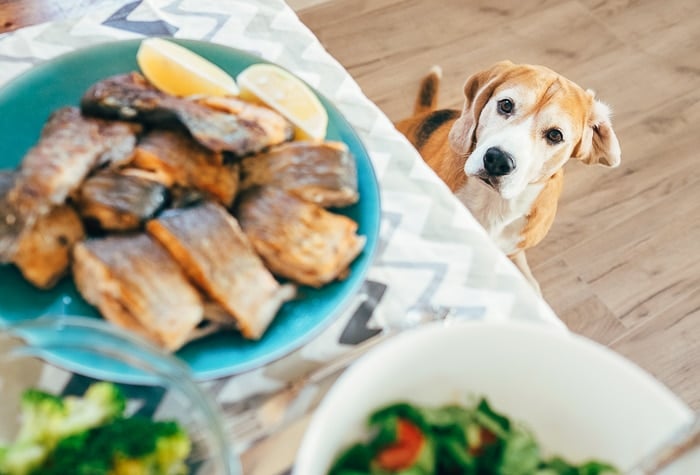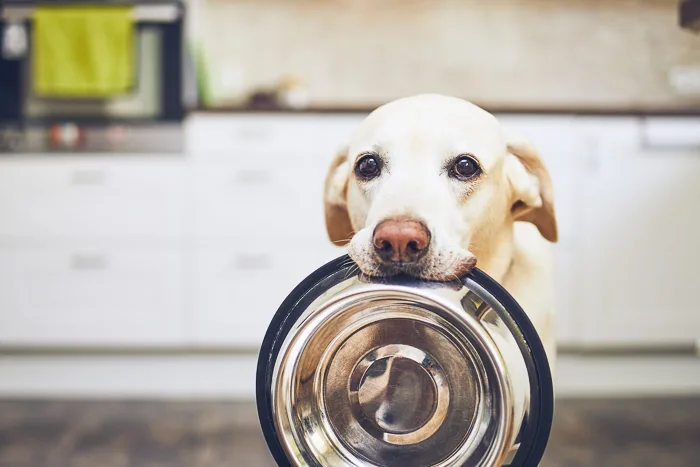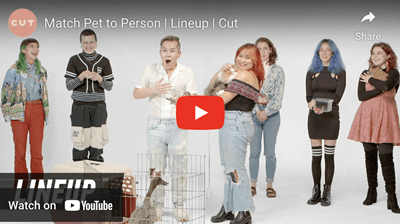Some dogs need to be on a low sodium dog food for one reason or another. Trying to find the best low sodium dog food for your pooch can seem overwhelming at first, but with the right tools, you can find the low sodium food product for your dog that you need.
Just like with any dog food, you should have a general idea of what you are looking at, your veterinarian's recommendation, and some patience while searching.
Dr. Jess breaks down her vet-recommended over-the-counter low sodium dog foods below:

So, is low sodium food really the best option for your dog or are we all just overreacting with this? Let me, the veterinarian, explain my thoughts…
The products listed in this review are all lower in salt. So let's take a deeper look at a few more things you might want to know before starting your low sodium dog feed search.
It’s always best practice to double-check which feeds your dog can and can not eat because many foods that seem completely safe and healthy for most dogs, may not be that way for your dog.
That's why I am so glad that you are here making an informed decision before feeding your dog a low sodium diet!
If you missed it, check out my article on if dogs can eat different forms of salty fish here!
Typical Canine Diet:
Some dogs aren’t too picky about what they eat. They’ll eat whatever you try to give them- they're like vacuum cleaners sucking up anything put in front of them!
There are some dogs are pickier than others. Pickier pups can be harder to properly feed because they just won't swallow any food we try to give them.
Try feeding a choosy dog something like okra or many of the healthy complete feeds made for dogs!
A common pet canine diet consists of a complete dry or wet feed and possibly supplements in some specific cases (not all pet dogs need supplements however).
There is also foraging if the dogs are allowed to roam or are feral, and of course there are treats!
The diet of every dog breed can very and is important to know when offering food to your dog.
An improper diet could put your dog at risk of having problems properly digesting their food and absorbing nutrients correctly. And we don’t want that now do we???
So let’s hone in on and talk about low sodium diets and how it could affect your dog’s overall health and potential health concerns.

Salt Is Essential!
Sodium is an essential mineral for dogs. The American Association of Feed Control Officials (AAFCO) states that adult dogs require a minimum of 0.3% or about 100mg per 100kcal of sodium in their diet.
Sodium plays an essential role in electrolyte balance as well as nerve and muscle cell function. Here are a few other roles sodium plays in your dog’s overall health:
- Regulates blood volume.
- Maintains blood pressure.
- Helps maintain muscle and nerve function.
- Helps form a stomach acid essential to digestion.
Natural sources of sodium include foods like meat, fish, and eggs.
Salt is also commonly a component of many commercial dog foods in the form of table salt, the same stuff that us humans eat.
For most dogs, this isn’t a problem, but high sodium levels can be problematic for dogs with certain medical concerns.
Healthy dogs are able to excrete excessive sodium amounts out through their urine. One popular study even shows that dogs are able to adapt fairly well to a wide range of sodium levels [source].
Sodium Levels:
So what is the correct amount of sodium for your dog? Here are some guidelines you can follow. Of course, the quantity guidelines can vary depending on numerous factors such as health problems, breed, weight, and size.
Here is a commonly used set of guidelines provided by Vermont Veterinary Cardiology Services:
- Dogs with no sodium restrictions require food with at least 0.5% sodium content (>100mg sodium/100kCal)
- Mild Sodium Diet: 0.3-0.4% (% of DRY matter) or 80-100 mg per 100 calories
- Moderate Sodium Diet: 0.2%-0.3% or 50-80 mg of sodium per 100 calories
- Marked Sodium Diet: 0.15%-0.2% or 40-50 mg of sodium per 100 calories
- Extreme Sodium Diet: 0.075%-0.15% or 20-40 mg of sodium per 100 calories

Salt Levels in Dog Food:
The right amount of sodium your dog needs to stay healthy depends on many factors, such as your dog's health, size, weight, and breed.
One of the best ways to control how much sodium your dog is consuming is by looking at the nutrition label on their dog food.
It can sometimes be difficult to find the sodium information in certain dog foods.
Dog food manufacturers are not required to print this information on their packages. If you can't find any sodium information on the packaging, you can often times get this information by calling the company or by doing an internet search.
Generally speaking, wet dog food tends to contain larger amounts of sodium versus dry dog food.
Why Do Dogs Need Low Sodium Dog Food?
A need for a low sodium diet usually comes from a concerning veterinary diagnosis.
Dogs with heart failure, high blood pressure, and a multitude of other conditions, are often recommended to be placed on a diet with lower sodium, as this can help in the prevention of certain conditions such as strokes, heart problems, and other medical concerns.
Hydration:
Too much salt may lead to dehydration in dogs just like it can in humans. Too much salt can affect their circulatory system and kidney function. It can also lead to things like persistent diarrhea.
Managing Blood Pressure:
Increased sodium can mean an increase in blood pressure. High blood pressure can lead to a number of cardiac (heart) conditions, strokes, and heart attacks.
Switching to a lower-sodium diet can help at-risk dogs regulate their blood pressure better.
Senior Health:
Senior dogs can suffer from conditions like poor nerve function and muscle issues, which can lead to movement issues and pain problems.
Decreasing sodium consumption can help prevent these conditions from worsening and help to subdue current symptoms.
Common Medical Conditions that Warrant Low-Sodium Dog Food:
Conditions that may require a lower sodium diet:
- Heart Disease
- Liver Disease
- Kidney Disease
- Hypernatremia
Heart Disease:
One condition that may require a lower sodium food is heart failure.
Dogs experiencing heart failure may get tired easily, have difficulty breathing, or excessively cough due to a buildup of fluids.
Heart failure affects the way blood is pumped through the body and can cause excess fluid to build up, which is known as congestive heart failure.
Dogs with heart disease do not eliminate excess sodium like a healthy dog can, and this can cause them to retain extra water.
Extra fluid in the bloodstream puts pressure on the heart and other internal organs in the body like the lungs and kidneys.
Heart failure can be life-threatening and too much sodium can worsen the problem.
Dogs that are at risk for developing congestive heart failure can therefore benefit from reduced salt in their diets.
Liver Disease:
The liver filters toxins from the blood and helps with other normal body functions like digestion. A reduced-sodium diet can help manage the effects of certain liver disorders.
Kidney Disease:
The kidneys filter out excess sodium and other minerals and excrete them out into the urine.
When your dog has renal (kidney) disease or kidney failure, they may not be able to remove extra salt from their systems.
This may lead to water retention and may severely impact your dog's health.
Salt Toxicity:
When that happens, they suffer from a condition called hypernatremia, or salt toxicity.
Hypernatremia occurs when your dog ingests something with a lot of salt in it and they can’t get enough water to dilute the sodium intake. This leads to an excess of sodium in the bloodstream.

What to Look For in High-Quality Dog Food?
Besides having low-sodium ingredients, you need to make sure that the basic composition of the food is right for your dog, ensuring that your pup has all the essential nutrients that they need to stay happy and healthy.
Protein:
Protein is one of the most important things to focus on when you're shopping for any type of dog food.
Dogs are carnivorous by nature and need a healthy supply of protein to ensure that their bodies function properly.
Carbohydrates:
Carbohydrates can be a valuable source of additional nutrients and energy in your dog's diet.
Vitamins, Minerals, and Supplements:
The rest of the ingredients in a commercial dog foods will vary dramatically from manufacturer to manufacturer.
The key is to look out for items that will directly benefit your dog!
Dry vs. Wet Dog Food:
There are both dry and wet foods with low sodium options available.
Dry kibble is ideal for dogs that have no problem chewing their food. There is the added benefit that the texture of the dry kibble helps to keep the teeth clean.
Wet food is softer and easier to eat and also has a much higher moisture content than dry kibble does. The extra water content in wet food will help to keep your dog hydrated.

Does it Taste Good? Do Dogs like the Taste of Low Sodium Dog Food?
Most dogs don't mind the taste or texture of low-sodium foods. The taste and texture are very similar to their normal counterparts.
Vet-Recommended, Over The Counter, Low Sodium Dog Food:
Before you make the switch to a low sodium dog food, it's important that you speak with your veterinarian about the diet change and any questions and concerns that you may have beforehand. They'll be able to determine if your dog needs this new form of diet.
If your dog needs to be on a low-sodium diet, there are many formulas to choose from.
Here are some of Dr. Jess’s favorite over-the-counter options for your four-legged friend:
Does My Dog Need Low Sodium Dog Food?
Dogs in general are fine to eat food with sodium in them. Only after testing and a diagnosis has been made, can a veterinarian tell you if your dog has high blood pressure, heart problems or anything else that might make them more sensitive to salt than healthy dogs.
How To Switch Your Dog To A Low Sodium Diet:
Switching your dog to a new diet of any kind should be done with care.
It is heavily ill-advised to just swap their old dog food for the new one without an initial period of slowly introducing them to the new food over time.
This gradual switch over from their old food to the new one should be done over 1-3 weeks, depending on factors such as the age of your pet, the dog food in question, and any health concerns that your veterinarian has.
Your veterinarian will have the best recommendation on the amount of time it should take YOUR dog to switch from old to the new food, but just be aware that it’s not an overnight process.
How To Tell if Your Dog Is Having Adverse Reaction To New Food?
If introduced to quickly, your dog can find itself with some severe gastrointestinal issues and upset, such as vomiting, diarrhea, inappetance, and lethargy.
If you pup acts differently after being offered a new food, contact your veterinarian immediately to see what they say you should do next.
Resources:

![[Vet Explains Pets]](https://vetexplainspets.com/wp-content/uploads/2024/09/cropped-vetlogo-199x66.png)
